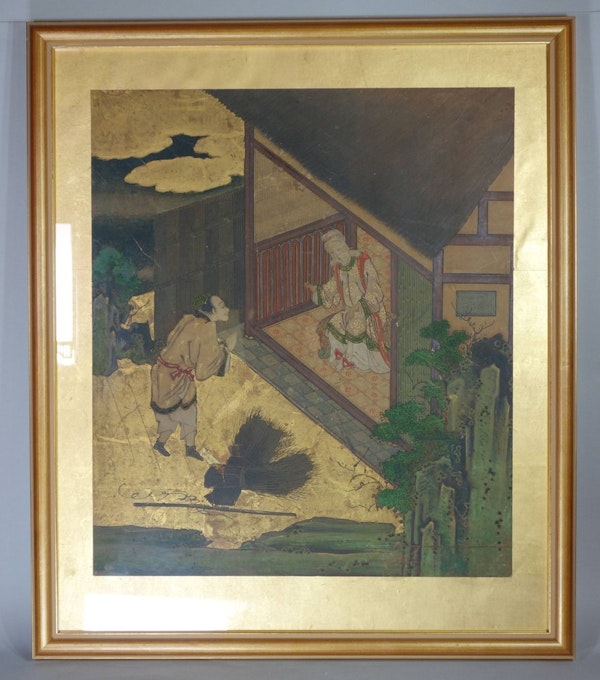Japanese Kano school painting, 17th century
Japanese Kano school painting, 17th century
POA
Description
Japanese Kano school painting, 17th century, in ink against a gold leaf background, depicting Zeng Shen, having dropped the firewood he has gathered, and approaching his elderly mother, who is standing on the veranda of a pavilion, the garden with rockwork, pine and golden clouds.
Notes: The themes and styles of Chinese art have had a signifiant influence on Japanese painting for hundreds of years, with genres including bird and flower studies, Buddhist religious paintings, inkwash landscapes, and, as seen here, depictions of traditional Confucian tales proving especially popular in medieval and early modern Japan. Despite thematic and stylistic similarities to Chinese models, Japanese paintings display a distinctly Japanese aesthetic. Mirroring this wider narrative of influence and innovation, the Kano school of painters, founded by Kano Masanobu in the 15th century, initially adhered closely to Chinese models, contributing to a revival of Chinese influence within Japanese medieval culture. However, over time the school developed a bolder, more distinctive style with firm outlines and brighter colours, as seen in this example. The Chinese text Quan xiang ershisi xiao shi xuan 全相二十孝詩選 (Selected verses on all aspects of the twenty-four filial exemplars) was compiled in the fourteenth century by the Yuan dynasty Confucian scholar Guo Jujing. The compilation of tales outlining the central Confucian concept of loyalty towards ones parents proved extremely influential across Asia and was translated into Japanese as Nijushiko 二十四孝 in the fifteenth or sixteenth century as well as becoming a popular theme in Japanese art. The tale depicted in this painting is 啮指痛心, Nie Zhi Tong Xin (He Felt Pain in His Heart When His Mother Bit Her Finger), which tells the tale of Zeng Shen, a young man from a poor family who was out collecting firewood one day when he felt a sudden pain in his heart and knew to rush home as quickly as he could. Some visitors had arrived at the house while he was absent and his mother, hoping that the strong bond between son and mother would summon him when she felt pain, bit her own finger. He indeed felt her pain deeply and came rushing back to find his mother at home. She told him the reason for having summoned him thus and all present praised his filial piety and sense of duty towards his mother.
| item details | |
|---|---|
| Material and Technique | Ink on gold leaf |
| Origin | Japanese |
| Period | 17th Century |
| Dimensions | Dimensions of frame: 40cm. x 46.4cm. (15 3/4in. x 18 1/4in.) |
Product REF: Q707K


